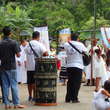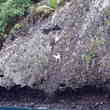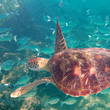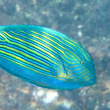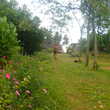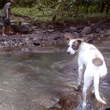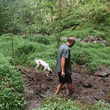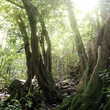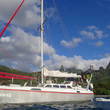This page is an automated translation of /nl/marquesas2.html and is awaiting a manual review.

Despite very high expectations, we are very positively surprised about the Markiezen. Paradise exists! It is rough, green, warm in terms of climate and warm in terms of humanity, tidy and tidy, without real poverty, pure and fair, a country with bananas and many other tropical fruit trees and basil and peppers as weeds. If only we had that in the Netherlands, instead of the sorrel and nettle.
In Marquises part 1, we arrived at the sea in Hiva Oa after a month and we stayed at the island of Tahuata, at the village of Hapatoni, where we have very good memories. After Hapatoni comes Fatu Hiva. This island is high on our 'must see' list, we actually wanted to arrive here after the long crossing of the Pacific. Ben Rutte described the island and the bay very visually in his -very pleasant and well-written- book 'They will never take that away from you!'. Ben signed that book for us after his presentation at the Hiswa and wrote in it "Get out!". It has been a final push for us to take the plunge, make a dream come true and just DO it. Get out, don't wait, there are always 100 reasons to postpone something, but we all know the saying 'postponement comes ... right, cancellation. Problems are there to come up with solutions and that is how we eventually arrive at the magical Fatu Hiva ....
Fatu Hiva


This morning we left Hapatoni very early so that we can sail slowly in the light wind, without having to use the engine, well before dark in the Baie de Vierges on Fatu Hiva. The most beautiful bay of the Marquises is said (not only Ben). Could it be ...? We are anxiously waiting for us to get closer, we have been looking forward to this for years. Then it can only be disappointing, right? But it doesn't. It is beautiful, a really beautiful bay. Rock pillars with beautiful warm colors tower stately from the sea. Goats climb the impossibly steep slopes, palm trees adorn the rocks and grow where they are actually not possible at all. In the background you can see the gorge and the impressive mountains that are completely overgrown. It's a beautiful sight. When we arrive here the sea is calm and we lie quietly in this bay, but that is often different, wave action is a well-known problem here but we are lucky.
There is a waterfall here, Ben described it so beautifully; his Annemiek stood with her sun-bleached long blond hair in her sun-tanned skin under the waterfall, it was the perfect Fa advertising picture.
If they used tough sun-tanned men with sexy beards as Fa commercials, Frans would be the perfect picture right now. We are at the waterfall and it is wonderful to immerse ourselves in the fresh fresh water. The route here is very beautiful and along the way we met a number of local people with whom we started a nice chat. Ladies wanted to trade fruits for perfume and lipstick and things, and a man wanted to give us limes for nothing. He's happy to have lost some weight I guess, he's got a heavy bag of limes that will go on the supply ship later today and will be sold in Tahiti. We accept two limes, no more because we are still completely loaded with fruit from Hapatoni. "Oh and maybe you have very large or very small fish hooks and want to exchange that for other fruit, or honey, I make honey myself" he says in French. We want to exchange brackets for honey! We agree to come by tomorrow and give him about 8 nice brackets and tell him to see what he wants to give for it. We get more than half a liter of pure honey AND papayas and oranges. Good deal, everyone happy!
Just stop by Tahuata and Hiva Oa
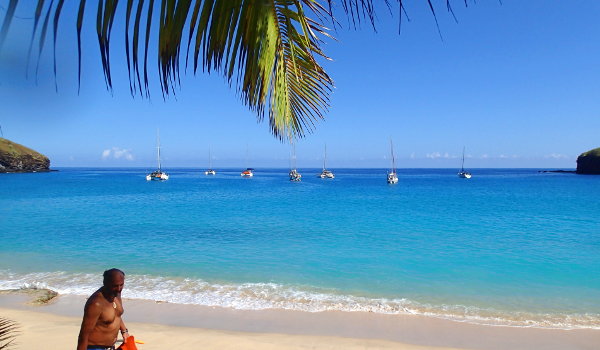
After five wonderful days on Fatu Hiva we sail back to Hapatoni on Tahuata and have an incredibly interesting and enjoyable day and evening with Tii. We give him an orange so that he can use the seeds to plant orange trees here. Strangely enough they only grow on Fatu Hiva ... He asks if we want to stay until Saturday, then there is a big party, dancing, singing, food made by the villagers, completely free and for nothing. Very attractive and we really want to but we know that we really cannot stay longer, we have been here for a long time and there is so much to see. Unfortunately! We say goodbye and hope to see him and the other lovely people of Hapatoni again!
The next morning at six o'clock we sail away from the bay that we have come to love and where it is usually nice and quiet with few other boats. The goal today is to go to the most famous and most popular bay of Hapatoni; Hanemoenoa. According to Hiscock the most beautiful bay. Fair is fair, visually this is a nicer bay. Beautiful white beach and because there is a white beach and the bay is shallow, the water is beautifully turquoise and just as clear as the bay north of Hapatoni. But there are no people living there and it is suffocating (well, there are 7 others). The snorkeling is very nice and we like to do that for a few hours. Then we leave for the north of Hiva Oa, Hanamenu. The water here is opaque and brown, but the bay is nice to explore on foot.
Ua Huka


This island has more goats and horses than people and according to the pilot it has been completely eaten bare. There is an 'invisible bay' which, according to the pilot, is described as follows: "Vaipaee is an extremely narrow gorge with high steep black mountains rising vertically from the sea. The waves break violently on the rocks and you can hardly see the entrance. and it looks dangerous. Behind the white breakers you will find a very narrow, imposingly steep but quiet bay. " The description appeals to us, but to be honest it is all much less exciting than described. Still, we have a good time here. It is really very different from the previous lush areas we saw. The rocks are black and hardly anything grows, indeed wild goats and horses eat it completely bare! There are a few supermarkets and a church in the small village. The people are very friendly again and we are allowed to watch a dance exercise. They practice for the month of July, where there is a big party every weekend. The party originates from the French 14 July, but here in the Marquises they make a party of it for a whole month :-) The men do a sexy and tough Haka dance.
Nuku Hiva
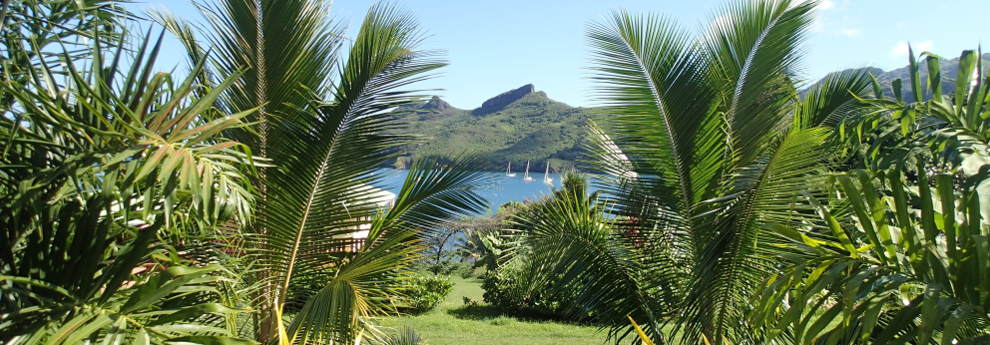
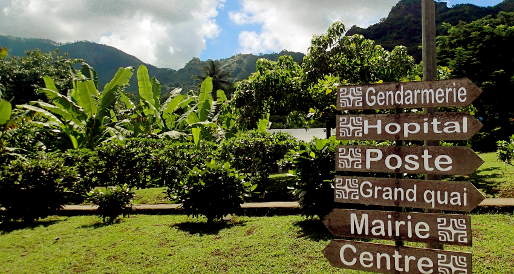
The main island of the Marquises is Nuku Hiva. We have internet work and we can do that well here in the main bay of the capital; Taiohae. When you think of 'capital' you probably think of busy streets, lots of people, traffic, shops, lots of noises and screaming sirens? Adjust that picture if you think of the 'capital' of the Marquises! There are few streets (but they are made of concrete and no longer of sand), few people, not much traffic and whatever drives, drives quietly and without exception they are 4x4s. There is hardly any lighting, not many shops but a cheerful atmosphere and there is not much, especially nothing touristy for sale. People are relaxed and friendly but who wouldn't be in such an environment ...! The bay is huge, but is still very beautiful, green and attractive.
I am always amazed at how little pollution there is here. Literal pollution (waste on the street), you will not find that at all here, but you will not find construction pollution here either. No matter how beautiful the sea is and how beautifully impressive and green the islands are (and how much people would like to live here - would you think?), The coastline is pure and unspoilt. It is very different here from so many parts of the world, here the coastal areas are not cursed with large buildings that spread like mold in a warm climate. Here in the Marquises it is pure and beautiful. Even on the main island - where we are now - there is no (construction) pollution, not even in the capital. And when you walk down the street in the capital at night, you notice that there is really hardly any lighting and you need a flashlight when the moon is not shining!
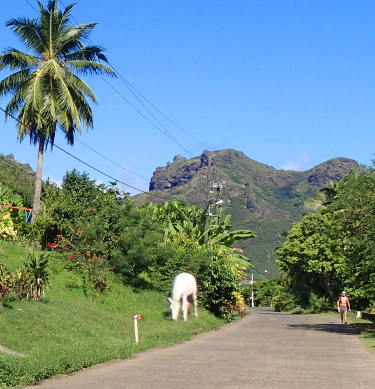
The internet is far from finished and we cannot enjoy the beautiful island by far enough. One thing we definitely want to do is walk to the third highest waterfall in the world. For that we have to go to the (internetless) bay Taioa. We sail out of the bay of the capital Taiohae, we drag the dinghy behind the boat because we are only five miles away. We left later than planned because the gas bottle was ready later than agreed. We are therefore in a dilemma, should we go or not? "We can make it if we leave NOW and if something goes wrong, we can easily and safely get back to where we came from" we say to each other almost in unison. Okay, so decided, let's go. We want to see that third highest waterfall in the world with our own eyes tomorrow! And that is why we are here now, nervous because it is getting darker fast and we are not going into an unknown anchorage in the dark. To my left I see a darkening ocean with the island of Ua Pou ("wapoo") in the distance at 35 miles. To our right are waves breaking on a beautiful rocky coast. It rains thick drops of tropical water and the black sky does not make it any lighter. Fortunately, the calculation is correct and we sail just in time past the white breakers at the entrance to the bay. What a beautiful sheltered spot and we are lucky, there are hardly any other boats so there is plenty of room to drop our anchor in this beautiful bay. The village is not visible from the anchorage, it lies just on the other side of a rock and behind a green wealth on a river. From the anchorage we see a white sandy beach with swaying palm trees, steep green mountain slopes and that is all attractive here, but that has to wait until tomorrow. Now a sundowner to celebrate that the five miles went well and tomorrow before dawn - that expression is not very appropriate; there is no dew here! - into the dinghy, up the river and start the hike to the waterfall. It is more than 2.5 hours to and 2.5 hours back and my hair has to be washed so the shampoo lasts, something different than washing hair in the sea as I have been used to doing the last 8 months ...
Taioa is a village without an access road. The only way to get there is by sea (and then a stretch of river), or on foot. It is a 3 to 4 hour walk to the nearest next village. This valley used to be quite busy inhabited, but now there are only 21 people living here.
Hike to the third highest waterfall in the world
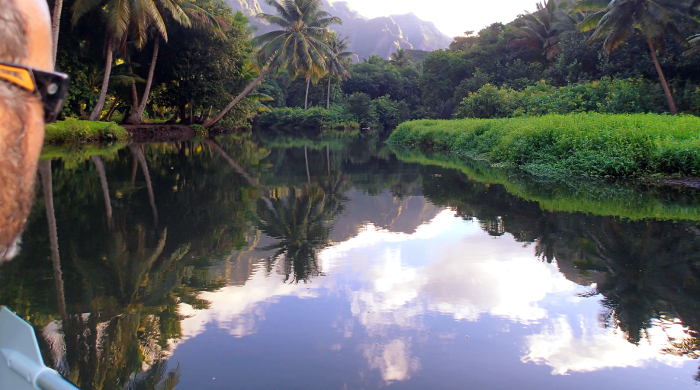
French, get up! I wake him up at five, we eat breakfast in the cockpit, pretend it's normal to have a view of coconut palms on a white beach, pack our things and get into the dinghy at six. We are looking for the entrance to the village. There is a river running past the village and it is quite exciting to enter it because the water is rough on the border between fresh and salt and is also quite shallow. We are very careful and that is a good thing because we later hear from two others that they broke their propeller. We use our paddles and go rafting up the slow flowing river. When we get out, have moored the dinghy and still admire how beautiful the valley is, we suddenly hear wild barking and three dogs come running towards us. One - the largest - is carrying a long broken chain. Swallow. Fortunately, the dogs only appear to be very happy and feel like a walk! Everyone is hospitable here in the Marquises, even the dogs ;-) It is very funny that we are suddenly walking three dogs. They relieve themselves and run happily back and forth and stay close to us. Then we meet two other dogs but this time there is a woman. It's Monette. She speaks to us and asks if we would like to come for dinner after the walk? Bien sure! She urges us to watch out very carefully for falling rocks and coconuts. Yes, we have known for a long time that those Fa commercials are not that sensible; you never know whether something harder will come down from such a waterfall besides water. And to the question whether many people here are killed by falling coconuts, the laconic answer is "just one" ...

The walk takes us through the valley that starts quite wide and ends in a narrow gorge with spectacular vertical rocks. Everything is overgrown and we walk in the shade. After a while we lost two of the three dogs. The third is a very affectionate dog with eyes that radiate a great love and loyalty and walks nicely with us, very happy to be with us. At the river she starts to squeak and we release her completely, but when we have taken off our shoes and waded through the fast-flowing river, she still goes along bravely and is completely delighted again. We call her Stip and she is our dog today.
During the trip we see many memories of the past, there are still many paepae to see, the natural stone foundations on which houses were built in the past. We walk through forests for the most part and occasionally there is a very nice viewpoint where you have a good view of the truly spectacular rocks and from a distance we can already admire the waterfall. The narrow nature trail winds through the gorge that is getting narrower. Stip seems to know the way and often runs ahead of us, but every time we have to cross the river again she suddenly loses track well in advance and seems clearly disappointed when we realize that we have to cross the river again somewhere. We get closer and closer to the waterfall and the gorge gets narrower and the walls steeper.

Suddenly there is a crater in the middle of the path. Gosh what happened here? The ground has been freshly turned upside down, plants are upside down, tree branches have been snapped and the crater is strewn with fresh splinters of wood and crushed stones. Stones! We look up and see the 600 meter high rock face leaning over us. All around us we see fresh craters and large boulders with fresh fractures. It has rained the day before and that has apparently released a lot and it looks life-threatening. So that was what Monette meant when she warned us to watch out for the stones! Never walk here while it is raining I would say, really dangerous. And um, watch out for falling rocks, how do you do that? And what do you do when such a boulder comes down? Warding off doesn't make much sense and jumping to the side quickly isn't that obvious because of the dense vegetation. It is only a short distance to the place where the waterfall comes down and we decide to do this bit very quickly. To be honest, the waterfall on site is quite disappointing. The waterfall itself is not accessible now. The water in the pool at the waterfall is thick brown and there is a huge pile of fallen branches in front of the entrance. When we try to get closer, we see a downwind and we make a quick turn around, it is hundreds of meters high and we wouldn't be surprised if there are still some loose stones that are about to fall. Too bad about washing your hair, you have to do that in the river.


We leave the scary part with all the fresh craters and decide to eat our sandwich by the river. Very nice with the three of us on a rock, Frans, Stip and me. Frans and I enjoy our feet in the cool water. Stip doesn't feel like a sandwich and drops it in the river. Moments later Frans is shocked because I start screaming like a retarded. There is a very thick hose of one meter long that comes swimming towards us !!! He is as fat as Frans his calf and his head is a bit thicker and he looks mean with fake little eyes and a big mouth full of sharp teeth !!!! I am trapped, Frans and Stip are in the way, I have nowhere to go and I am only a few centimeters from the dangerous looking beast. He's really not acting normally at all, he acts pushy and it looks like he wants to get on the stone too. My feet fly out of the water and I quickly stand. Frans laughs badly but is just as scared and got up quickly. Even Stip finds it scary and stands with her tail between her legs looking at the weird slippery snake beast ... Nice then, we have to cross the river three more times and that beast keeps swimming around here. Now I am so stupid to feed him because that is so much fun ..... He turns out to love bread and even half the water comes out with a wide open mouth. But yes, now he really does not want to leave and we still have to cross ... In the meantime, we are punctured by the mosquitoes that have also found us and are not impressed by our (outdated?) Deet lotion. We have to go now. But that monster is still here and swims laps, often with its mouth wide open trying to see every leaf floating past whether it is edible. Frans gently throws a small stone on his back and wow, that has a great effect, he is startled and swims away with a huge splash. I quickly arm myself with three stones in one hand, my shoes in the other, and cross the river. My young one, that feels different now that we have just seen what lives here. You just have to wash your hair in the sea.
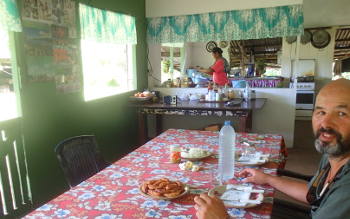
Walking the whole route back and crossing the now 'scary' river three times, we return to the starting point and the sympathetic Monette awaits us with a delicious lunch. Dough in a delicious coconut sauce, salad of grated green papaya (what a versatile fruit!) With a super tasty soy-garlic sauce, poison cru that is really very good and soft in a coconut sauce and fried bananas. It is enough for six people and what we cannot eat she packs for us in trays so that we have two more days to eat. This time it is not free, she asks 1500 Polynesian Francs per person (about 12 euros). It is different than we were used to before, but we are glad she wants something for it because this is really too much to assume. We are also on the main island and that makes a difference; we also see that the fruit on Nuku Hiva is sold instead of (just) given away or traded. She also wanted to exchange for long trousers, but unfortunately I did not bring them extra. Oh and Monette laughs at our story about 'that scary beast', it turns out to be a friendly moraine being fed by the guides and therefore acting so unnaturally intrusive. The poor animal can't help it that he's so ugly and looks so dangerous, right?
After we sail back to the main bay and have dealt with the most important internet matters, we leave for the last island on our list of Marquises. Ua Pou. Are you already crazy about the Ua's, Hiva's and Nuku's in the names of the islands? We get lost every now and then.
Ua Pou

Again we leave early so that we arrive in Ua Pou, Hakahetau bay well before dark. We can stay here for 1 day and then there is a good weather hole with calm but not windless conditions to the Tuamotus, an opportunity that we cannot pass up because many cruisers experience terrible weather here with strong wind and a lot of thunder or are floating for days without wind . "Hey, isn't there Plastik Plankton lying there?" Frans asks me. Do you remember that funny radio voice with that German accent? It turns out to be true and they are a very nice couple. Furthermore, this bay is deserted. Not surprising, because there is a lot of swell, but we find that very pleasant in the preparation for the upcoming four-day crossing to the Tuamotus; it prepares your body for the movements so that you have less chance of seasickness. The bay is very special with a view of a number of very high vertical rock pillars. It turns out to be solidified lava, so the inside of what was once the volcano! The lava that came up was apparently very hard and the surrounding volcanic mountain has disappeared due to erosion, leaving only the inside visible. A special effect!
Because the Marquises are a paradise with their edible fruits that grow like weeds everywhere, and the Tuamotus are an opposite (almost only coconut trees want to grow there), we want to load them with fresh fruit here. During our walk through the village we meet Jean Louis, a cheerful friendly guy who passed by yesterday with a broad grinning in his wooden canoe. He will provide fruit, he says and we meet in a few hours on the village terrain by the sea.
The village terrain is very beautiful and has tables with benches under a tree. There is a nice breeze, a view of the sea and we can sit in the shade. Not bad! We decide to read here on the laptop in the Tuamotus Compendium. It is already certain that we will go tomorrow, but we still have to decide exactly 'where are we going'.

Villagers arrive and greet us kindly and sit nearby and have brought all kinds of food. A nice dinner with family members and friends. We thank as kindly as possible when they ask us if we want something but they don't accept it. One by one they join us and we are kindly served a plate. The plate contains a delicious papaya mix and also pieces of raw fish, with bones and skin and all, totally unprepared. No sauce. Raw fish cut into a few pieces. Not quite our taste, to be honest, but yes it is hospitable and nice! Fortunately, Frans is sweet and takes care of the bulk and discreetly shares 'the bones' with a street dog. One of the men is Jean Marc and it just so happens that he knows Cyril! He himself makes the same type of jewelry. He invites us to have dinner with him tomorrow evening but unfortunately we have to decline because we are leaving. Jean Louis, meanwhile, arrives with a wheelbarrow full of fruit. We ask what he wants for it and the answer is 'four beers?'. Good exchange as far as we are concerned! Two huge combs with bananas, lots of grapefruit, melons, etc. and all in all at least 40-50 kg !!
It just gets used to us, we get used to it, but when I think back to the Netherlands - or actually any other country I've ever been to - it is really very abnormal that people are so generous. How logical is it for a family that is eating outdoors to share their food with foreigners? What is the chance that -after a pleasant hour of chatting- you will be invited by your interlocutor for dinner the next day completely selflessly? Wolfgang, from Plastik Plankton, was in the village in the meantime and was also invited to join in for a barbecue. What a special country this is. Or does it say more about our own not so social culture and is this normal ...?

In the evening we try to catch a fish with the remaining fish waste. Frans warns me: "not that big, you'll catch a shark!" I stubborn as usual and a little later we have a real shark on the leash. Fortunately he escapes and we stop fishing, eat a piece of bread and go to bed early so that we can sail early the next morning to the Tuamotus. Exciting journey, exciting destination. Here countless ships sailed up the reefs and were lost.
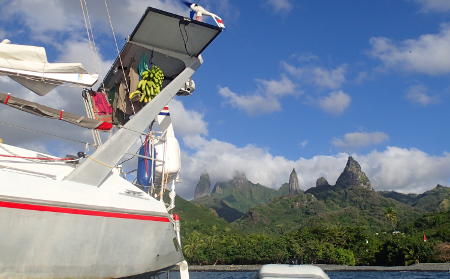
The destination is Raroia we came up with. An atoll with a relatively easy entrance, a small village on 1 island and otherwise uninhabited, very clear water, many sharks and other underwater life, numerous beautiful islands with palm trees and white beaches and it is the place where the famous Kontiki is stranded. We leave the Marquises with pain in our hearts, we really love the lovely people and beautiful nature, but we are also looking forward to the next adventure. Tuamotus here we come!
There are already quite a few photos in this page, but many are still missing. So here's another photo series:
Day Marquises!



